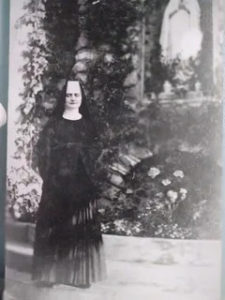A letter from Bishop Andrew Cozzens of the Crookston Diocese released Oct. 15 announced that preliminary steps are being taken that could lead to opening a cause for the canonization of Sister Annella Zervas, OSB.
Zervas died at the age of 26 in 1926 in her family home in Moorhead, Minnesota, after a debilitating and painful skin disease.
Amanda Zurface (no relation to Zervas, although pronounced the same), a canon lawyer, read the bishop’s letter at the Our Lady of Lourdes Grotto in the St. Benedict Monastery cemetery in St. Joseph, Minnesota, where Zervas is buried. Approximately 150 people gathered for the event, many of them part of a monthly group that has been praying for Zervas’ canonization.
Although Zervas died almost 100 years ago, she remains very much alive in the hearts and minds of a growing number of people, largely because of the efforts of Patrick Norton, a house painter, husband, and father of three from Avon, Minnesota.
On Oct. 27, 2010, while painting light posts in front of the grotto, Norton says a religious sister in an old-style habit appeared to him and told him he was doing a good job. They chatted a bit, and when she turned to go, she vanished before his eyes. He later identified her as Sister Annella Zervas through photos and discovered she was buried in that cemetery. Since then, he has felt called to share her story far and wide.
In the letter he wrote, Cozzens thanked the group for “perseverance in prayer and witnessing to the importance of living a holy life as seen in your commitment through spreading the message of Sister Annella.”
The bishop shared that he too is inspired by the nun’s story, which he first learned about through his own sister. He acknowledged receiving many requests from people to begin the formal process of investigation to determine her holiness. However, he noted, “there are formalities and stages that involve canon lawyers, historians, theologians, and doctors to instructing a cause of beatification and canonization. … I ask that you be patient as we follow the procedures set out for us by the Church for a study such as this, and I also ask for your prayers.”
Cozzens shared the website For the Promotion of the Life of Sister Annella Zervas, OSB, for people wanting to stay informed about the study of Zervas’ life, to share a story about her, or to report answers to prayer through the nun’s intercession.
Was a cause ever opened?
When Zervas died, many believed she was a saint. Two booklets about her life were written: “Ticket to Eternity,” by James Kritzeck, published in 1957, and “Apostles of Suffering in Our Day,” written by Benedictine priest Joseph Kreuter and published in 1929.
There is uncertainty as to whether there was ever a cause opened for Zervas.
Older writings often refer to Zervas as “Servant of God,” a title given to a candidate for sainthood after a cause has been opened and is under investigation prior to being declared “Venerable.” (Venerable is the title given to a candidate whose cause has not yet reached the beatification stage but whose heroic virtue has been declared by the pope.)
“That is one of the things that needs to be investigated,” Zurface told CNA at the cemetery prior to the reading of the letter. She credited Norton with resurrecting an interest in Zervas’ life.
According to Norton, 100,000 copies have been distributed of the booklet “Apostles of Suffering in Our Day.”
People have also learned of Zervas through an interview Norton did in a video titled “The Sanctity of Two Hearts.”
Those praying for the Benedictine sister’s intercession have reported miracles and answers to prayers. But the Church is always cautious about such things, Zurface said, so it’s premature to say any more than is in the letter.
Monsignor David Baumgartner, rector of the Cathedral of the Immaculate Conception in Crookston and the other canon lawyer preparing the groundwork for the cause, noted in a phone interview that the main tasks right now are to work on bylaws to form a guild and to establish it as a nonprofit organization.
A “guild” is the traditional association formed to support, through prayer and promotion, a candidate for sainthood.
“When the guild is established, they will be the ones to petition for a cause to open,” he explained. “The letter was presented at this time, so people will be aware of what the diocese is doing in regard to Sister Annella.”
After the reading of Cozzens’ letter, Norton shared with the group his own story of how he came to know Zervas. And Rose Lindgren from Sartell, about 10 miles from St. Joseph, told the group she was healed of bladder cancer five years ago without treatment after praying to Zervas.
A life of suffering
Zervas was born Anna Cordelia Zervas in Moorhead, Minnesota, on Palm Sunday, April 7, 1900. Even as a young girl, she had a deep interior life, taking great pains to prepare for her first holy Communion and walking a mile daily to attend Mass.
She left home for the Order of St. Benedict in St. Joseph at age 15 in August 1915. Her letters home reflect her happiness, but she also battled with terrible homesickness. When she made her perpetual vows in 1922, she said that any doubts as to her vocation vanished. But by the following year, a peculiar skin disease attacked her body, which included terrible itching day and night.

Zervas continued her work as a music teacher at St. Mary’s School in Bismarck, North Dakota, until eventually her condition made it impossible. Her body began to swell, her skin turning a deep red and burning. Her swollen limbs oozed and developed sores; her skin sloughed off in chunks and strips; thornlike stickers developed within her pores and had to be painfully removed.
Zervas was diagnosed in 1924 at the University of Minnesota with pityriasis rubra pilaris, a chronic skin disease that had no medical treatments at the time. With the consent of her superiors, she was transferred to her parents’ house in Moorhead, Minnesota, where her mother cared for her for two years until her death.
“The pains became more intense; the patient’s cheerfulness remained the same,” Father Kreuter wrote in “An Apostle of Suffering in Our Day.” “’Yes, Lord, send me more pain, but give me the strength to bear it,’ is a prayer that was repeatedly uttered by Sister Annella in the midst of excruciating pains of body and anguish of soul which lasted almost continually for two long years.”
At the end, a priest brought the Blessed Sacrament and placed it on the communion table before her. “Peacefully, she passed away in the presence of her sacramental Lord, surrounded by her parents, brothers, and sisters reciting the rosary and a prayer to St. Benedict for a happy death on Aug. 14, 1926,” Father Kreuter wrote. “The penetrating, nauseating odor of corrupt flesh that had followed in the wake of her ailment disappeared altogether from the moment of her passing.”
She was placed in her parish church in a simple casket of black in her religious habit, the crucifix she had kissed so often in her hands. From there she was moved to St. Joseph, where she is now buried.

